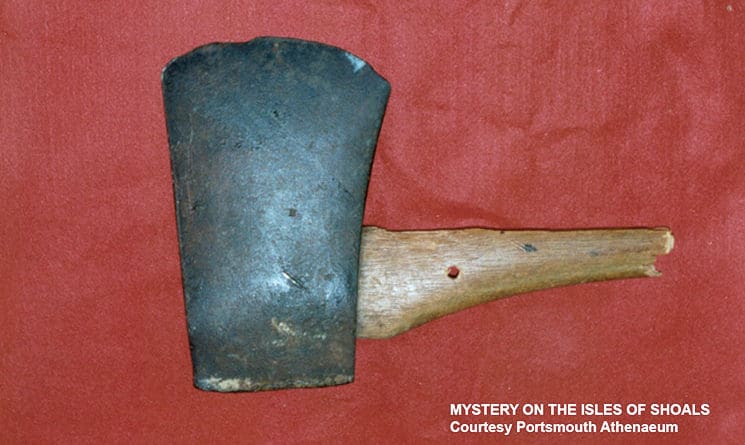Just a few feet from the stone wall separating Portsmouth’s South Cemetery and Route 1A are two gravestones cut in white marble. The graves are unremarkable, but the story behind them has captivated locals and visitors for generations. The stones mark the final resting place of Anethe and Karen Christensen, the victims of the Smuttynose murders — a crime so sensational that it’s endured in the Seacoast’s collective imagination for over 140 years.
Like any good true-crime story, though, the facts of the case have been muddied. In the decades since Louis Wagner was convicted of killing the Christensen sisters, hoaxes, false accusations, and a best-selling novel (and it’s cinematic adaptation) have made the murders into the stuff of pulp fiction. But historian J. Dennis Robinson wants to shift the focus back to the truth. His latest book, “Mystery on the Isles of Shoals: Closing the Case on the Smuttynose Axe Murders of 1873,” out this month from Skyhorse Publishing, offers what he calls a definitive account of the Smuttynose murders.
“We pass along our opinions about stories we know very little about. We skim the surface, but don’t dig deep,” says Robinson. “The local legends surrounding the infamous Isles of Shoals murders are based, almost entirely, on false rumors, hoaxes, misunderstandings, and out-and-out-fiction.”
If the cobwebs of myth and rumor and fiction have obscured anything about the crime, Robinson says, it’s Wagner’s role as the murderer. Stories have persisted since his arrest in 1873 that Wagner was wrongly convicted. Those stories, in turn, were bolstered by Anita Shreve’s novel, “The Weight of Water,” and its subsequent film adaptation directed by Kathryn Bigelow and starring Sean Penn.
In the novel and film, Wagner is a scapegoat and Maren Hontvet, the sisters’ companion and sole survivor of the crime, is the real killer. Consumed with guilt in her later years, she offers a deathbed confession. This fictionalized ending stems from false reporting at the time that Maren — who was alive in Portsmouth — confessed to the killings before passing away. In reality (and in fiction), Wagner was found guilty and hanged for the crime in June 1875. Rumors of Maren’s guilt can be traced back to Wagner’s own testimony. At his trial, he claimed Maren had killed her sisters and spent the evening near the rocks developing her story. Wagner sympathizers note what they consider key facts that point to Maren’s guilt: the difficulty Maren would’ve had identifying Wagner in the dark; the shallow stab wounds found on Anethe and Karen, which suggest an attacker without great strength, and the erroneous myth that no money was taken from the home.
Roninson, though, says the facts tell a different story. “Wagner had method, means, motive, and opportunity,” he says. “Every scrap of evidence pointed to him, and his alibi was entirely unsupported and contradictory to the facts. I want readers to come to know him and see what a creep he really was.”
“Mystery on the Isles of Shoals” isn’t a whodunit so much as a why-dunit, with a focus on Wagner’s motives for murder. “I know who did it, and only need to convince the reader why,” Robinson says.

Robinson, a prolific writer and long-time Seacoast historian, spent two years doing research for the book. He read newspaper clippings, studied hundreds of pages of trial transcripts, and pored over documents relating to the trial left to him by Dr. Robert and Dorothy Tuttle, who died while compiling their own work on Wagner.
“I studied the way newspapers reported ‘facts’ in the Victorian era, studied the lawyers on the case and the court system, visited Wagner’s jail cell in Maine, spent a lot of time on Smuttynose Island, researched the fishing industry that is a key factor in the murders, examined the police department procedures in the 1870s, looked into the transportation systems, the science of blood analysis, and read every word written by previous authors about the murders,” says Robinson.
The sympathy that Wagner has earned in the decades following his conviction is undeserved, Robinson says. He describes Wagner as a “loner and down on his luck, impoverished, jealous, a slacker, a parasite, a chronic liar … charming and glib.” However, at the time of his trial, headlines and articles boasted of Wagner’s innocence. “Wagner does not look like a villain. Put him amongst a dozen respectable laboring men, and none would select him from the others as a bad man,” Robinson quotes one Portsmouth Evening Times reporter in the book.
The case against Wagner was solid, though. He couldn’t account for his whereabouts on the night of the murder and John Hontevet, Maren’s husband, whose house was the scene of the crime, testified that Wagner asked, on multiple occasions, if the sisters would be home alone on the night the murder was committed.
Why have the rumors and fictions endured? “I think we often prefer myths to facts in order to make a story sound more exciting. But the real story here, for me, is much more interesting than the rumors and conspiracy (theories),” Robinson says. “In our cynical, post-Kennedy, murder-mystery world, we like to think that the cops and the lawyers are always wrong. But, sometimes, the creaky complex criminal justice system actually works.”
J. Dennis Robinson will read from “Mystery on the Isles of Shoals” at RiverRun Bookstore, 142 Fleet St., Portsmouth on Wed., Dec. 3 at 7 p.m. and at Barnes & Noble, 45 Gosling Road, Newington, on Thu., Dec. 4 at 7 p.m. The book is available locally at RiverRun Bookstore and Water Street Bookstore in Exeter.


